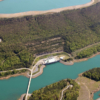Field Services
Installation of instruments, setup of data acquisition system
Wind Turbine Strain Monitoring is a service offered by the Canary Systems Civil Group. A wind farm in Texas was interested in evaluating the current state of the rock-to-foundation interface during operation of its turbines. The wind farm consists of over 100 wind turbines, the majority of which are supported on rock-socketed, mono shaft foundations. The 660 kilowatt turbines can produce up to 82.5 megawatts of electricity purchased by Texas utility companies.
Canary Systems provided field services that included installation of the instruments, set-up of the data acquisition system and supervising the data collection during the production period for each turbine. To complete an accurate evaluation, we collected and evaluated a combination of tilt and strain measurements recorded throughout an 8 to 12 hour production period for 5 specified turbines.
Installation of instruments, setup of data acquisition system
Utilize MLSuite to monitor during set-up and production period
Review existing foundation information and provide technical evaluation
Over the course of 1 week, our engineers installed the instrumentation and organized data collection for the turbines, then continued data analysis and reporting for another 2 weeks. The data acquisition system consisted of a Canary MLDAQ, specifically designed to read a tiltmeter and strain gages at high speeds (20Hz). This high-precision voltage and frequency measurement control module collected and stored the bi-axial tilt sensor data and data from each of the six vibrating wire strain gages. The bi-axial tiltmeter was installed as close as possible to the center point of the turbine floor to record changes in tilt of the foundation. The strain gages were installed on the interior surface of the turbine at 60-degree increments, which were used to measure the changes in strain experienced at the base of the turbine.
Canary Systems engineers then installed and configured our MultiLogger Suite® software on a field laptop to provide monitoring during the initial set-up and production period, as well as data collection after the production period testing was completed. The collected data files were then processed to provide values for the subsequent engineering analysis. The datasets were uploaded to a temporary database within Canary’s online MLWeb platform. Within the database, engineers were able to create and export calculations, charts, spreadsheets, and graphs to review the data.
The exported graphs for review included stress and windspeed vs. time, histograms of rotational stiffness, rotational stiffness vs. windspeed, and rotational stiffness and windspeed vs. time. The strain gage data indicated that when the turbine was in operation, a higher stress rate was observed.
We provided a review of the existing foundation information, a technical evaluation of the stresses and loads based on the strain gage data, and other factors (wind speed, direction, etc.). The calculated rotational stiffness for the five turbines was found to be above the OEM limits while the turbines are in operation.

 Automated Remote Monitoring for Large Mines
Automated Remote Monitoring for Large Mines